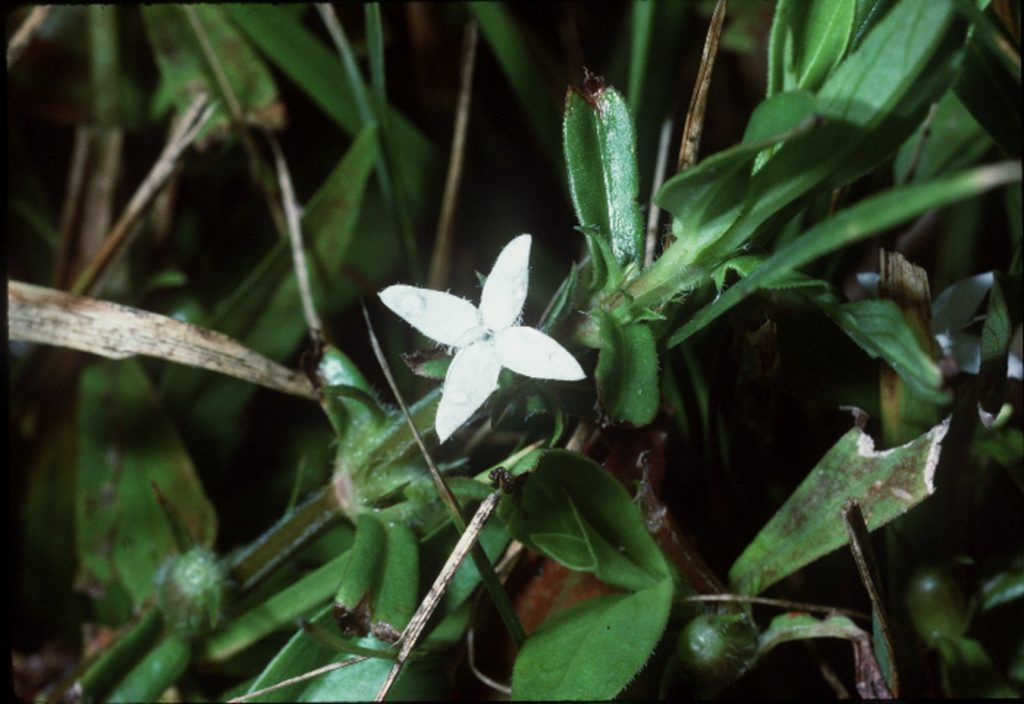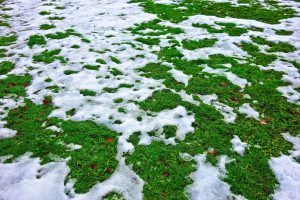Virginia Buttonweed (Diodia virginiana) is a common broadleaf weed that can be troublesome in both turfgrass lawns and ornamental beds.


Virginia Buttonweed (Diodia virginiana) is a common broadleaf weed that can be troublesome in both turfgrass lawns and ornamental beds.

The fescue and/or bluegrass lawn that is so prevalent in Henrico is reliably winter hardy. However, while well adapted to winter, these cool season turf varieties may be injured in cold weather. There are a number of things that you can do and also not do to minimize the risk of winter turf damage.
BE ON THE LOOKOUT FOR THESE WINTER DISEASES:
Snow Molds: Snow molds are not nearly as big of a problem in Virginia lawns as they are further north. However, when they occur, they certainly attract a lot of attention. Following winters with extended snowfall, it is possible that cool-season lawn grasses have been attacked by either pink or gray snow mold. The blighted turf will be a circular patch of varying size of matted down turf. The diseases are more likely to occur on succulent turfgrass leaves that received very high levels of fall Nitrogen fertilization; so again, proper fall fertilizer is key. It is not generally recommended that home lawns be treated for snow molds because the disease is rarely going to kill turf in this setting. Use a heavy garden rake to work up the matted turf in the affected areas in order to increase air and moisture movement into the turf canopy. Observe the area over the next 7 days or so to see if new shoots are emerging from the crowns. If you don’t see any signs of new growth after that time period, then plan on reseeding these areas.
Red Thread or Pink Patch: Spring-like temperatures and plenty of moisture result in ideal conditions for turfgrass diseases to make an appearance in lawns, particularly cool-season grasses. The disease present is likely one of two things: Red thread or Pink patch. The bright red to pink mycelial growth of this fungus is plainly visible early in the morning, particularly when the dew is still on the grass. The disease will remain an eyesore as long as cool, moist periods persist, but the fungus only attacks the foliage and rarely will the entire plant die. What should you do to manage this disease? Almost always, the proper treatment is to leave it alone rather than applying a fungicide. As the weather warms and dries, red thread and pink patch will gradually disappear.
Part 1 of this series can be found here.
Part 2 of this series can be found here.
The fescue and/or bluegrass lawn that is so prevalent in Henrico is reliably winter hardy. However, while well adapted to winter, these cool season turf varieties may be injured in cold weather. There are a number of things that you can do and also not do to minimize the risk of winter turf damage.
BE ON THE LOOKOUT FOR THESE WINTER PESTS:
Winter Weed Control: Maintaining a vigorous turfgrass stand will protect against weed infestation. However, during the winter months turfgrasses are not actively growing and are, therefore, susceptible to the encroachment of winter annual broadleaf weeds. Winter annuals germinate in the late summer and early fall months, live during the winter and die in the latespring or early summer with the onset of high temperatures. Examples include annual bluegrass, common chickweed, purple deadnettle and henbit.
Controlling winter annual broadleaf weeds before they are able to set seed will not only reduce the likelihood of an outbreak the following year, but improve the aesthetic quality of the turfgrass stand.
Control of winter annuals includes removing plants now by hoeing or hand pulling. Broadleaf herbicides can also be effective if used while the weed is actively growing or before the weed flowers in spring. Realize herbicides are not effective at cold temperatures. Generally postemergence herbicides are used when temperatures are > 50o F. Be sure to read and follow all label directions.
Voles: Voles will make runways under lasting snow cover in lawns as they feed on grass blades and roots and are protected from predators. Damage is frequently mistaken as mole damage, but moles are not active during winter and actually tunnel below the soil surface. Vole damage appears as runways or winding trails of damaged grass. Lawns usually fill-in as conditions warm in spring. A winter without lasting snow is an excellent avenue of free vole control, as vole activity on exposed lawn areas will be greatly reduced without the protection provided by the snow.
Part 1 of this series can be found here.
The fescue and/or bluegrass lawn that is so prevalent in Henrico is reliably winter hardy. However, while well adapted to winter, these cool season turf varieties may be injured in cold weather. There are a number of things that you can do and also not do to minimize the risk of winter turf damage.
Proper Fall Fertilizer: Did you fertilize correctly in the fall? In Henrico, the last date to apply fertilizer is the end of November. Fertilization during the winter period leads to higher potential leaching and runoff risk of the nutrients.
Final Cut: The final cut of the season should be on the lower recommendation for height for fescue or bluegrass. That would make your final cut of the year at 3” height. This keeps your grass from getting too tall and having those tall blades that flop over on itself which can promote diseases. After your final mowing, put you lawn mower to rest for the winter by having the blade sharpened and performing a tune-up.
Stay off Frozen Turf: Trafficking on frost or ice-covered turf usually results in extensive physical “breaking” of the leaves. The xylem and phloem tissues that are involved in moving water, nutrients, and carbohydrates around in the plant are usually severed when traffic is applied to ice-covered foliage. The damaged turf leaf blades don’t fall away completely from the stem, but instead slowly turn brown and die. So follow the practice of golf courses and stay off frost covered or frozen turf. It is OK to go on turf covered by snow. The snow will help cushion and protect the blade from damage as well as protect it from extreme cold.
Stay off Overly Saturated Turf: Winter rains or melting snow can make your lawn saturated with water. When this happens, stay off the turf to avoid compaction. Remember that you just aerated the lawn in the fall to improve compaction in the lawn; do not undo that work now by walking over overly saturated turf.
Be Careful with Ice Melt Materials: Standard ice melt compounds are usually some form (or combination of) chloride-based salts. Limited use of any of these products should cause little injury. Problems begin when they are used excessively and there is not adequate rainfall to wash or leach the material from the area. We are often prone to over applying ice melt just to make sure the ice and snow melts. Keep in mind this can damage concrete surfaces as well as the plants and grass growing along the walks and driveways. If problems develop, they are normally latent and do not show up until spring or summer